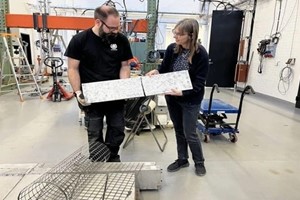In a groundbreaking development aimed at revolutionizing the construction industry, pioneering researchers at Chalmers University of Technology in Sweden have unveiled an innovative method for producing environmentally sustainable textile-reinforced concrete structures.
With global cement production exceeding 4.5 billion tonnes annually and accounting for 8 percent of worldwide CO₂ emissions, the need for eco-friendly building practices has never been more pressing. Catharina Björk and Mia Halleröd Palmgren, in their published work on innovation, stress the importance of replacing steel reinforcements with textiles in concrete. This switch allows for the construction of sleek, lightweight structures using less material, resulting in a significantly reduced environmental footprint.
While acknowledging the existing technology to utilize carbon fiber textiles, Björk and Halleröd Palmgren highlight the challenges, particularly in establishing a reliable calculation basis for complex structures such as intricate vaulted designs.
To address these challenges, researchers at the university are introducing a method that simplifies scaling up analyses, thereby streamlining the construction of eco-friendly bridges, tunnels, and buildings.
Karin Lundgren, a professor in concrete structures at Chalmers, emphasizes that a significant portion of the concrete currently used is dedicated to protecting steel reinforcement from corrosion. She suggests that by switching to textile reinforcement, cement usage can be reduced, leading to lower environmental impact.
Cement, serving as a binder in concrete, contributes significantly to climate change through its production from limestone, which releases stored carbon dioxide. The global cement industry is responsible for approximately 8 percent of worldwide carbon dioxide emissions, prompting efforts to explore alternative materials and methods for constructing concrete structures.
By utilizing alternative binders such as clay or volcanic ash instead of cement, it is possible to reduce carbon dioxide emissions and achieve thinner constructions, thereby lowering the carbon footprint. However, the long-term effectiveness of these new binders in protecting steel reinforcement remains uncertain.
Lundgren suggests that addressing the corrosion protection issue can be achieved by opting for carbon fibers as reinforcement material instead of steel, as they do not require the same level of protection. Additionally, optimizing thin shell structures can yield significant benefits in terms of reduced climate impact.
In a recent study, Lundgren and her colleagues introduced a novel modeling technique proven to be reliable in describing how textile reinforcement interacts with concrete. This method simplifies the calculation process for complex structures and reduces the need for load-bearing capacity tests.
Textile reinforcement technology has the potential to significantly reduce environmental impact, particularly in the construction of arched floors. A prior research study conducted by the University of Cambridge revealed that utilizing textile reinforcement can reduce carbon dioxide emissions by up to 65 percent compared to traditional solid floors.
A textile reinforcement mesh comprises yarns, each composed of thousands of thin filaments or long continuous fibers. When integrated into concrete, the reinforcement mesh allows for filaments to slide against both the concrete and each other when under load. Understanding this behavior is crucial for determining the load-bearing capacity of the textile reinforcement.
The modeling technique developed by the researchers at Chalmers University accurately captures these effects, considering the interaction between the inner and outer cores of the yarn under concrete loading. Through experiments, the reliability of this approach has been demonstrated, even for complex structures.
Collaborative work with colleagues is now focused on refining optimization methods for larger structures. As the United Nations Environment Programme forecasts a doubling of global floor area in the next 40 years due to rising prosperity and population growth, optimizing resource efficiency in construction is essential to address the climate challenge, emphasizes Lundgren.













